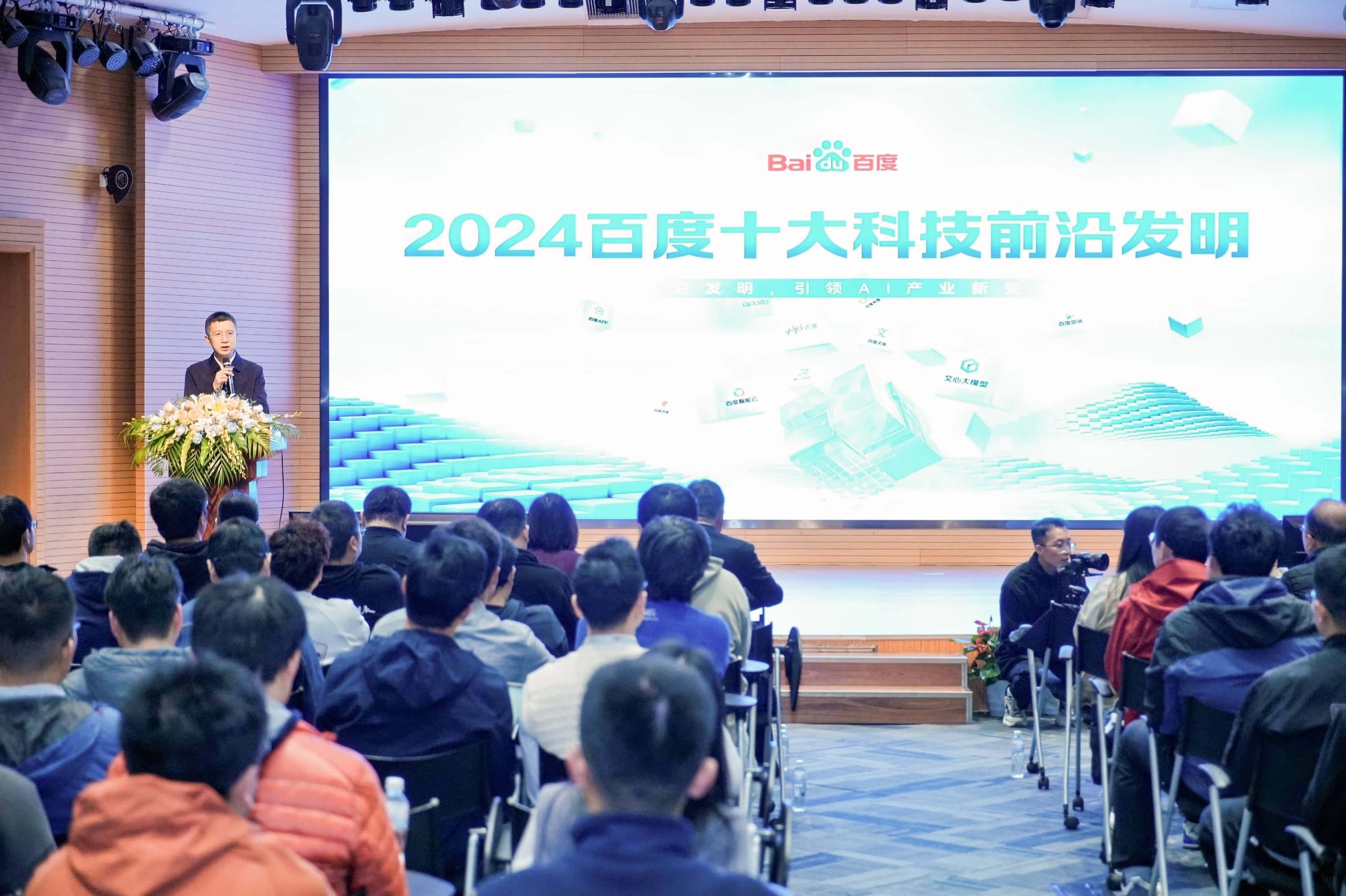2024-10-28
Back to list
On October 22 in Beijing, Baidu unveiled its list of the ten most significant frontier technological inventions in 2024. The list, which Baidu has released annually for the past three years, this year highlights foundation models as key drivers of innovation and productivity in industry sectors, with AI-native applications now seamlessly integrated into all aspects of production and everyday life.
Baidu CTO Haifeng Wang said that these frontier inventions not only advance Baidu’s products and operational efficiency but also are catalyzing the AI-native transformation of the company’s ecosystem, enabling various industries to leverage the power of AI. Baidu has been exploring and making progress in foundation models since 2017, pushing the boundaries of agent capabilities and fostering their application across numerous sectors.
Lingling Cui, General Manager of Patent Affairs Department at Baidu, emphasized that this year’s list of frontier inventions not only showcases Baidu’s technological innovation but also reflects deep insights into future AI development trends. Baidu’s patented inventions in AI cover breakthroughs from foundational algorithms to applications, leading a new wave of change in the AI industry. Baidu aims to accelerate the industrialization of its patented technologies to enable intelligent advancements across various industries.
Since 2013, Baidu has significantly increased its R&D investment in AI, totaling nearly RMB 170 billion (~USD 23.4 billion) over the past decade. As of the end of 2023, Baidu led China in AI patent filings, with over 19,000 applications and over 9,200 patents granted, maintaining its leading position for six consecutive years. According to patent database firm IFIclaims, Baidu’s generative AI patent filings rank among the global top 10. The technologies on Baidu’s frontier innovation list represent Baidu’s vision of creating transformative industrial impact through innovation.
Baidu’s Top Ten Frontier Inventions of 2024
1. Generative Foundation Model-Based Agent Technology
Baidu’s agent technology introduces a cognitive model that integrates planning, tool usage, knowledge enhancement, and reflective evolution. It supports low-cost, large-scale development, deployment, and distribution of agents in various scenarios. Applied to domains like the ERNIE Agent Platform, Business Agent, and Baidu Comate, this technology significantly reduces development costs while enhancing AI-driven applications, such as marketing and human-machine collaborative programming.
2. Multi-Model Collaborative Evolution for Efficient Foundation Model Training
This invention optimizes both engineering and algorithmic aspects of foundation model training through hybrid parallel strategies, storage, and efficiency improvements. A dual-model pre-training approach allows seamless knowledge transfer between models, reducing training costs and improving speed. This technology has improved the ERNIE foundation model’s training throughput by 4.1 times in a year.
3. Knowledge-Enhanced Multi-Modal Intelligent Content Creation System
This system utilizes advanced knowledge enhancement, multi-source content parsing, and fusion editing, as well as retrieval-enhanced text-to-image techniques to generate high-quality, multi-modal content. Leveraging these technologies, Baidu Wenku now leads the intelligent slideshow creation market in China, with an 80% share, enabling users to generate reports, presentations, and more in real time.
4. Scalable Autonomous Driving Localization and Lane-Level Mapping Technology
This invention overcomes traditional efficiency and cost issues, reducing mapping costs by 95%, with lane-level coverage of over 3.6 million kilometers and nationwide road coverage across 41,000 urban and rural areas. Multi-modal sensor fusion enables centimeter-level precision, reducing map package size by 97.5% and achieving 99.9999% reliability, supporting large-scale deployment of fully driverless vehicles, even in complex environments like underpasses, multi-level roads, and tunnels.
5. Personalized Memory Mechanism for Intelligent Foundation Models
The mechanism replicates the hippocampus, a part of the human brain responsible for memory and learning, to deeply understand and accurately manage user information, ensuring real-time updates. Memory triggering and utilization assist the foundation model in generating more human-like and personalized responses. It is now widely applied in Baidu’s AI assistants and digital avatars.
6. Ultra-Realistic Digital Human Modeling, Control, and Generation System
This system introduces realistic human modeling, control, and generation. Baidu has facilitated human-like digital cloning and developed hyper-realistic 3D avatars comparable to movie-quality visuals, which are now used in livestreaming and digital human applications.
7. Foundation Model-Based Generative Commercial Search System
This invention breaks away from traditional indexed search methods by encoding commercial information directly into model parameters, enabling a new paradigm of “Model as Index” and “Generation as Retrieval.” This approach enhances targeting efficiency by 120%, driving innovative marketing solutions with improved quality.
8. Data Flywheel for Foundation Model Development
This invention integrates diverse feedback sources to automatically identify model deficiencies and synthesize high-quality training data. By combining multi-source feedback with reinforcement learning, it improves model training outcomes. The data flywheel breaks through data bottlenecks, reduces data costs, enhances adaptability and robustness, and accelerates model evolution.
9. High-Efficiency Inference for Foundation Models
This invention introduces efficient inference techniques built on the PaddlePaddle framework, incorporating innovations like PrefixCaching, Lookahead, and PagedAttention. These advancements significantly improve model throughput and performance. Using lossless quantization, it achieves efficient compression of foundation models. Applied in Baidu’s Qianfan Platform, these techniques save over 50% in deployment costs and boost throughput by 3-5 times.
10. User Data-Driven Retrieval and Generation System
This system integrates diverse user feedback signals to achieve rapid self-reinforcement. By modeling user satisfaction and using reinforcement learning to align with preferences, the system enables swift adaptation. Covering 18% of Baidu’s search traffic, it is applied to text, video, and image search scenarios, enhancing responsiveness and competitiveness.
Baidu will reveal further advancements during Baidu World 2024 in Shanghai on November 12th, promising yet another step forward for AI and the digital industry.